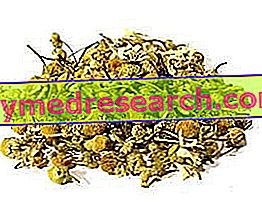Introduction
"Alternative drink to milk, the first medicine of children": it is with this definition that Camomile is called, or Matricaria Recutita, a plant par excellence that boasts spasmolytic (for internal use) and soothing (for external use) properties.
Chamomile belongs to the Asteraceae (Composite ) family and is currently widespread throughout Europe, America and Australia.
Popular use of chamomile

Chamomile is a drug of great popular use: used as a mild sedative, it is considered a real medicinal plant.
Already the Ancient Egyptians considered chamomile for pains in the limbs and neuralgia; they also attributed them to febrifuge properties and were considered by some to be the panacea for all ills.
In the Middle Ages, chamomile was considered an excellent aid against fatigue, for its tonic properties. It is said that even Alexander the Great used chamomile for his properties, and it was he who introduced this plant to the West.
If at one time it was used for its ability to calm anxiety, to calm pain and facilitate sweating in case of fever, in this article we will try to clarify whether all these properties attributed to chamomile have a foundation or not.
Active principles
First of all it must be remembered that chamomile is characterized by hydrophilic and lipophilic constituents, and that for each of these categories different typical properties can be recognized. The hydrophilic components include flavonoids, glycosylated coumarins and phenolic acids which, extracted with aqueous solvent, give the extract spasmolytic, sedative and antioxidant properties. In particular, the anxiolytic property is due to the presence of a flavonoid molecule called apigenin 7-glucoside. The other class of active ingredients, soluble in oil, is represented by terpenes (low molecular weight molecules, including ether cyclic monoterpenes and sesquiterpenes), coumarins and azulenes (camazulenes and bisabolol, extracted above all from the flower heads), which they attribute to the extract a typical blue color: these constituents contribute to the formation of an essential oil that boasts antiseptic, anti-inflammatory and soothing properties.
Here then is that from this distinction we can understand that infused chamomile has no soothing properties, since water is not the suitable solvent for extracting substances such as azulenes; by infusing the dried flower heads, on the other hand, all those constituents related to the hydrophilic solvent that characterize the drug with sedative properties will be obtained. In this regard, however, scholars remain debated: if the popular use of chamomile is known as a mild sedative, to combat insomnia and anxiety, recent studies have highlighted other factors: although chamomile is not attributed to toxic effects, its abuse would determine not only the opposite effect (insomnia), but also nausea. Apigenin 7-glucoside, on the other hand, appears to have positive consequences on anxiolytic effects, because it has a competitive link with benzodiazepine receptors (sedative anxiolytic drugs).
Uses in phytotherapy
The properties of chamomile are also used to alleviate stomatitis, dermatitis and mucosal diseases; it is also used in gynecological disorders such as dysmenorrhea and inflammation. It is also used in cosmetics as a lightener for hair, to make the chestnut hair clearer and the blond one more shiny.
Tradition teaches ...
Always recognized for its tranquilizing, sedative and decongestant properties, chamomile hides other very special notes: for example, it used to be time to put chamomile flowers on the bread smeared with garlic to make it more digestible.
Chamomile was also applied locally in the eyes, in the form of an infusion, in the treatment of conjunctivitis, to take advantage of its soothing properties.



